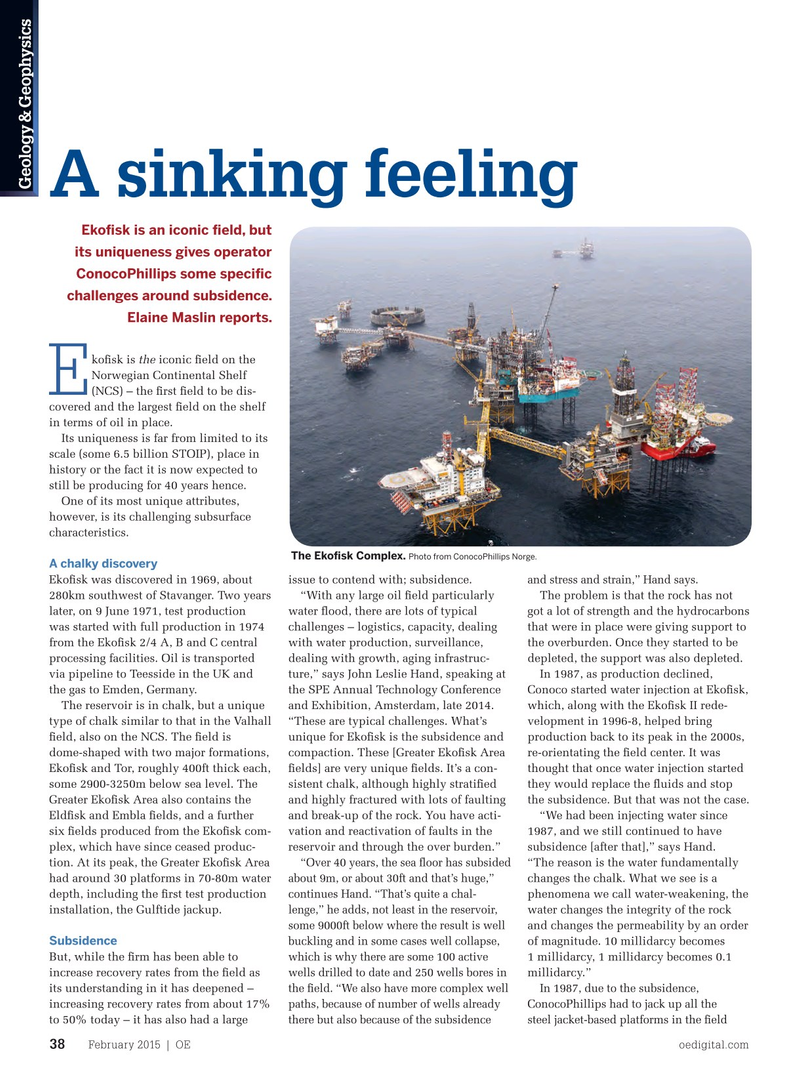
Page 36: of Offshore Engineer Magazine (Feb/Mar 2015)
Read this page in Pdf, Flash or Html5 edition of Feb/Mar 2015 Offshore Engineer Magazine
Ekofsk 1 –
Ekofsk 2 –
Ekofsk 3 –
Geology & Geophysics
A sinking feeling
Ekofsk is an iconic feld, but its uniqueness gives operator
ConocoPhillips some specifc challenges around subsidence.
Elaine Maslin reports.
kofsk is the iconic feld on the
Norwegian Continental Shelf
E (NCS) – the frst feld to be dis- covered and the largest feld on the shelf in terms of oil in place.
Its uniqueness is far from limited to its scale (some 6.5 billion STOIP), place in history or the fact it is now expected to still be producing for 40 years hence.
One of its most unique attributes, however, is its challenging subsurface characteristics.
Photo from ConocoPhillips Norge.
The Ekofsk Complex.
A chalky discovery
Ekofsk was discovered in 1969, about issue to contend with; subsidence. and stress and strain,” Hand says. 280km southwest of Stavanger. Two years “With any large oil feld particularly The problem is that the rock has not later, on 9 June 1971, test production water food, there are lots of typical got a lot of strength and the hydrocarbons was started with full production in 1974 challenges – logistics, capacity, dealing that were in place were giving support to from the Ekofsk 2/4 A, B and C central with water production, surveillance, the overburden. Once they started to be processing facilities. Oil is transported dealing with growth, aging infrastruc- depleted, the support was also depleted. via pipeline to Teesside in the UK and ture,” says John Leslie Hand, speaking at In 1987, as production declined, the gas to Emden, Germany. the SPE Annual Technology Conference Conoco started water injection at Ekofsk,
The reservoir is in chalk, but a unique and Exhibition, Amsterdam, late 2014. which, along with the Ekofsk II rede- type of chalk similar to that in the Valhall “These are typical challenges. What’s velopment in 1996-8, helped bring feld, also on the NCS. The feld is unique for Ekofsk is the subsidence and production back to its peak in the 2000s, dome-shaped with two major formations, compaction. These [Greater Ekofsk Area re-orientating the feld center. It was
Ekofsk and Tor, roughly 400ft thick each, felds] are very unique felds. It’s a con- thought that once water injection started some 2900-3250m below sea level. The sistent chalk, although highly stratifed they would replace the fuids and stop
Greater Ekofsk Area also contains the and highly fractured with lots of faulting the subsidence. But that was not the case.
Eldfsk and Embla felds, and a further and break-up of the rock. You have acti- “We had been injecting water since six felds produced from the Ekofsk com- vation and reactivation of faults in the 1987, and we still continued to have plex, which have since ceased produc- reservoir and through the over burden.” subsidence [after that],” says Hand. “Over 40 years, the sea foor has subsided tion. At its peak, the Greater Ekofsk Area “The reason is the water fundamentally about 9m, or about 30ft and that’s huge,” had around 30 platforms in 70-80m water changes the chalk. What we see is a continues Hand. “That’s quite a chal- depth, including the frst test production phenomena we call water-weakening, the lenge,” he adds, not least in the reservoir, installation, the Gulftide jackup. water changes the integrity of the rock some 9000ft below where the result is well and changes the permeability by an order
Subsidence buckling and in some cases well collapse, of magnitude. 10 millidarcy becomes
But, while the frm has been able to 1 millidarcy, 1 millidarcy becomes 0.1 which is why there are some 100 active increase recovery rates from the feld as millidarcy.” wells drilled to date and 250 wells bores in
In 1987, due to the subsidence, its understanding in it has deepened – the feld. “We also have more complex well
ConocoPhillips had to jack up all the increasing recovery rates from about 17% paths, because of number of wells already steel jacket-based platforms in the feld to 50% today – it has also had a large there but also because of the subsidence
February 2015 | OE oedigital.com 38 038_OE2015_G&G2_Ekofisk.indd 38 1/20/15 6:20 PM

 35
35

 37
37